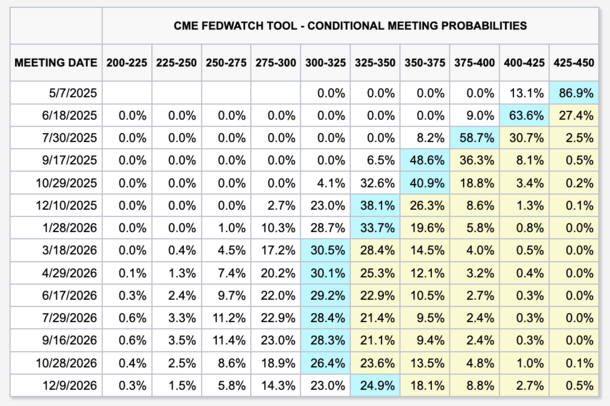There’s growing talk about Fed Chair Jerome Powell being fired by President Donald Trump.
Similar to his first term, he has lobbed insults at Powell while arguing that the Fed should lower rates.
But would doing so actually lead to lower mortgage rates? Or would it simply make matters worse?
It’s important to note that Powell is just one member of the Federal Open Market Committee (FOMC).
And that the Fed only controls short-term interest rates, while mortgages are long-term rates.
Can the President Fire the Fed Chairman?
First off, we should ask the obvious question, can Donald Trump even fire Jerome Powell to begin with?
At the moment, it’s a “probably not,” though a case in the Supreme Court could change that.
And Powell noted recently that “we’re not removable except for cause.” Lots of gray there, as the statement indicates.
But chances are it’s more rhetoric than reality, at least for now. In other words, Trump laying the groundwork now to get cuts without the actual removal of Powell.
Ironically, Trump was the president who appointed Powell in the first place, nominated on November 2nd, 2017 and sworn in on February 5th, 2018.
Despite that, Trump has consistently attacked Powell, both during his first term that started in 2017 and now during his second term.
However, he has significantly ratcheted up the insults this time around and appears to be more serious about ousting Powell, if he can.
In fact, on his Truth Social platform he called him a loser today and referred to him as “Mr. Too Late,” noting that he only lowered rates to help his opponents Joe Biden and Kamala Harris.
So clearly the stakes are getting a lot higher, but as noted, Powell is but one of 12 members of the FOMC.
Removing Powell Could Actually Lead to Higher Mortgage Rates
I wrote recently that high levels of uncertainty have been bad for mortgage rates lately, despite bad news often being good news for mortgage rates.
For example, if unemployment is rising and economic output is slowing, it can be a positive for mortgage rates because it means inflation is likely falling.
Lower inflation allows interest rates to come down to promote growth, consumer spending, hiring, etc.
But that hasn’t been the case lately due to the idea of stagflation, where you have slowing economic growth combined with high interest rates.
That’s what we saw in the 1970s and early 1980s, when inflation and unemployment, typically inversely related, both increased at the same time.
While times might be different, there’s a thought that lowering interest rates again when it’s unwarranted, could lead to similar conditions.
One could argue that monetary policy today isn’t overly restrictive, especially considering how bad inflation has been the past few years.
If the Fed were to lower rates prematurely, or lower them too quickly, inflation could rear its ugly head again and push long-term mortgage rates higher with it.
Remember, the 30-year fixed hit 8% in October 2023 as the Fed was battling the worst inflation in decades.
After getting that under control, we saw rates on the popular loan type come down to as low as 6% in September 2024.
And before Trump’s tariffs arguably raised mortgage rates, we were knocking on 5% mortgage rates’ door.
Simply put, the market doesn’t like his level of upheaval, and it would not surprise me to see mortgage rates shoot higher in the event of a Powell firing.
Especially if he were removed and the Fed kept its policy playbook unchanged. Or made it further restrictive.
Mortgage Rates Could Come Down if the Fed Restarted QE

The only real scenario where mortgage rates would come down due to Fed action is if they restarted Quantitative Easing (QE).
Remember, the Fed doesn’t control mortgage rates, even though many people (including maybe Trump) think they do.
The reason mortgage rates hit all-time lows in early 2021 was due to QE, when the Fed bought trillions in Treasuries and mortgage-backed securities (MBS).
But that was an unprecedented event related to a global pandemic. And the earlier rounds of QE in 2008 and 2012 were because of the Global Financial Crisis (GFC).
With the Fed as a major (and guaranteed) buyer of MBS, demand for mortgages became red-hot and lenders were able to lower interest rates significantly.
In short, when you have increased demand for bonds, their price goes up and associated yield (or interest rate) goes down.
That’s what we saw under QE, which resulted in those 2-3% mortgage rates. Of course, it also led to the Fed’s balance sheet growing exponentially.
And that eventually required Quantitative Tightening (QT), which is the unwinding of all those purchases via run off.
Instead of having a buyer of MBS like the Fed, you have more supply and one less very big buyer.
That has been one reason why mortgage rates went up as much as they did, fueled by inflation from the many years (if not a decade) of easy money policies.
So while the Fed could potentially restart QE and begin buying MBS again, which would sharply lower mortgage rates, the consequences might be disastrous.
It could lead to longer-term problems, including another inflation fight that consumers might not be able to absorb.
For the record, the Fed is currently projected to cut its fed funds rate up to four times by December as it stands, as seen in the chart above from CME.
Meaning they’re already expected to cut rates quite a bit this year, though again ironically, they are perhaps in a holding pattern due to Trump’s ongoing trade war.
Do We Need Lower Mortgage Rates Right Now?
Lastly, one could argue that mortgage rates aren’t the problem right now. Sure, some recent home buyers would love to refinance into a lower rate.
But prior to the election in November, mortgage rates were already in the low-6s and many quotes were in the 5s.
In fact, there were even quotes in the high-4s for certain VA loan scenarios where the borrower was paying a discount point.
Had we stayed on that course, millions of recent home buyers would have been able to take advantage of a rate and term refinance.
And many more prospective home buyers would have been able to make the leap to homeownership.
Instead, we were handed uncertainty related to tariffs, trade wars, tax cuts, and so on, all of which seemed to derail the lower mortgage rate trajectory.
So one could argue if we simply got back to the pre-election status quo, or were able to establish a middle ground on trade, mortgage rates would follow suit.
Ironically, this could allow the Fed to cut rates as Trump desires, likely resulting in lower mortgage rates at the same time.

